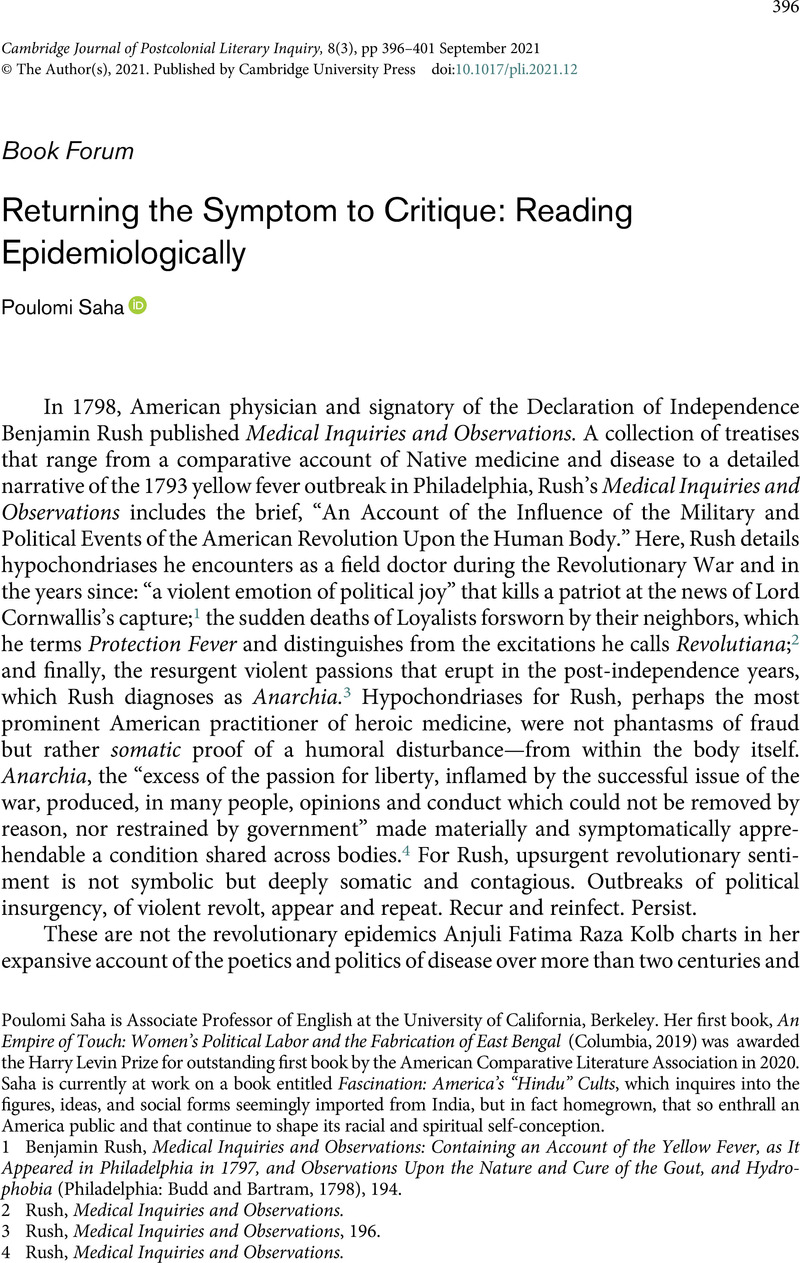No CrossRef data available.
Published online by Cambridge University Press: 11 October 2021

1 Rush, Benjamin, Medical Inquiries and Observations: Containing an Account of the Yellow Fever, as It Appeared in Philadelphia in 1797, and Observations Upon the Nature and Cure of the Gout, and Hydrophobia (Philadelphia: Budd and Bartram, 1798), 194.Google Scholar
2 Rush, Medical Inquiries and Observations.
3 Rush, Medical Inquiries and Observations, 196.
4 Rush, Medical Inquiries and Observations.
5 Kolb, Anjuli Fatima Raza, Epidemic Empire: Colonialism, Contagion, and Terror 1817–2020 (Chicago: University of Chicago Press, 2020), 4.CrossRefGoogle Scholar
6 Raza Kolb, Epidemic Empire, 21.
7 Raza Kolb, Epidemic Empire, 10.
8 Young, Robert C.. “Rereading the Symptomatic Reading,” in The Concept in Crisis: Reading Capital Today, ed. Nesbitt, Nick. (Durham, NC: Duke University Press, 2017), 40.Google Scholar
9 Freud, Sigmund, “Inhibitions, Symptoms, and Anxiety,” in The Standard Edition of the Complete Psychological Works of Sigmund Freud, Volume XX (1925–1926): An Autobiographical Study, Inhibitions, Symptoms and Anxiety, The Question of Lay Analysis and Other Works (London: Hogarth Press, 1926), 91.Google Scholar
10 Lacan, Jacques, Ecrits (London: W. W. Norton & Co., 2007), 195.Google Scholar
11 Freud, Sigmund, “Traumatic Fixation—The Unconscious,” in Introductory Lectures on Psycho-Analysis, trans. Strachey, James (New York: W. W. Norton & Co., 1966), 352.Google Scholar
12 Sedgwick, Eve Kosofsky, “Paranoid Reading and Reparative Reading; or, You’re So Paranoid, You Probably Think This Essay Is About You,” in Touching Feeling: Affect, Pedagogy, Performativity (Durham, NC: Duke University Press, 2003), 124.Google Scholar
13 Raza Kolb, Epidemic Empire, 17.
14 Rush, Medical Inquiries and Observations, 194.
15 See Foster, Kenneth R., et al., Bring Out Your Dead: The Great Plague of Yellow Fever in Philadelphia in 1793 (Philadelphia, University of Pennsylvania Press, 2014)Google Scholar; Jim Murphy, An American Plague: The True and Terrifying Story of the Yellow Fever Epidemic of 1793 (New York: Clarion Books, 2003); Thomas Apel, Feverish Bodies, Enlightened Minds: Science and the Yellow Fever Controversy in the Early American Republic (Palo Alto, CA: Stanford University Press, 2016); Simon Finger, The Contagious City: The Politics of Public Health in Early Philadelphia (Ithaca, NY: Cornell University Press, 2012).
16 Carrigan, Jo Ann, “Privilege, Prejudice, and the Strangers’ Disease in Nineteenth-Century New Orleans,” Journal of Southern History 36.4 (1970): 568–78.Google Scholar
17 See:Kathryn Olivarius, “Immunity, Capital, and Power in Antebellum New Orleans,” American Historical Review 124.2 (April 2019)” 425–455; Mariola Espinosa, “The Question of Racial Immunity to Yellow Fever in History and Historiography,” Social Science History 38.3–4(2014): 437–53.
18 See Jo Ann Carrigan, “The Saffron Scourge: A History of Yellow Fever in Louisiana, 1796–1905” (LSU Historical Dissertations and Theses, 1961), 666; Kenneth F. Kiple and Kriemhild Coneè Ornelas, “Race, War and Tropical Medicine in the Eighteenth-Century Caribbean,” in Warm Climates and Western Medicine, ed. David Arnold (Leiden, The Netherlands: Brill Rodopi, 1996), 65–79; McNeill, J. R., Mosquito Empires: Ecology and War in the Greater Caribbean, 1620–1914 (New York: Cambridge University Press, 2010).CrossRefGoogle Scholar
19 See Spielman, Andrew, Mosquito: The Story of Man’s Deadliest Foe (New York: Hyperion Books, 2001), 55 Google Scholar; Serpell, Namwali, The Old Drift (New York: Hogarth Press, 2019).Google Scholar
20 Quoted in Spears, John Randolph, The American Slave-Trade: An Account of Its Origin, Growth, and Suppression (New York: C. Scribner’s Sons, 1901), 158.Google Scholar